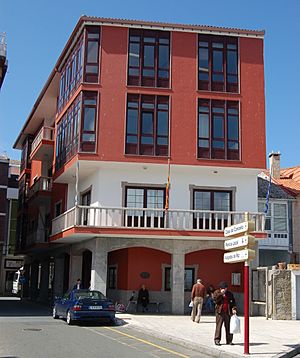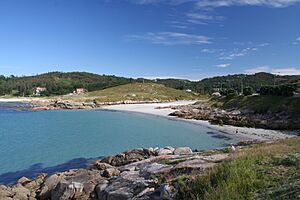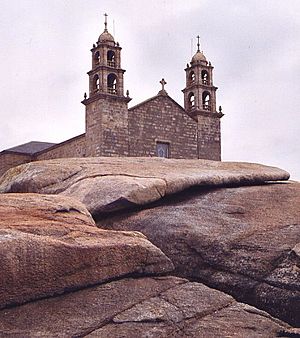Muxía facts for kids
Quick facts for kids
Muxía
|
||
|---|---|---|

Muxía town hall
|
||
|
||

Location of Muxía within Galicia
|
||
| Population
(2018)
|
||
| • Total | 4,736 | |
| Time zone | UTC+1 (CET) | |
| • Summer (DST) | UTC+2 (CEST) | |
Muxía is a pretty coastal town in northwestern Spain. It's located in the Galicia region, in the province of A Coruña. Muxía is part of an area called Fisterra.
This town is famous for its beautiful beaches. It also has a busy fishing industry. Muxía is a special place for many people. It's one of the last stops for pilgrims (religious travelers) on the Way of St. James. These pilgrims visit the shrine of Saint James the Great in Santiago de Compostela first.
Muxía is part of the 'Costa da Morte', which means "Coast of Death". This name comes from the many shipwrecks that happened along its rocky shores long ago. The Costa da Morte is also known as the "Seafood Coast" because of all the delicious seafood found here.
Just 3 kilometers from Muxía is the Church of San Xulián de Moraime. This church used to be a Benedictine monastery. The name "Muxía" actually comes from the monks who started this monastery! Another famous church nearby is the Santuario da Virxe da Barca. It stands on a rocky ridge right above the ocean waves.
Along the Costa da Morte, you can find special "rocking stones" called "pedra de abalar". Muxía has one of these, known as the "Pedra da Barca". These are huge stones that are so perfectly balanced that they can rock back and forth easily. Sometimes, they even wiggle when the wind blows! In the past, people believed these stones could help decide if someone accused of a serious crime was innocent or guilty.
In November 2002, a big oil spill happened near Muxía. An oil tanker called "Prestige" leaked about 70,000 gallons of oil into the Atlantic Ocean.
Contents
History of Muxía
Let's look back at Muxía's past.
Early Times
In the 400s and 500s, the region of Galicia was part of a kingdom ruled by a group called the Suevi. Later, in the 700s or 800s, the Moors took over. But then, the king of Asturias took control of the area.
The Moraime Monastery
The monastery near Muxía, called "Mosteiro de Moraime", was built in the early 1100s. It was named after Saint San Xiao de Moraime. Sadly, Norman pirates attacked and destroyed it in 1105. Later, another group called the Saxons also attacked it.
A young boy named Alfonso Raimúndez lived in the area. He was educated by Pedro Froilaz de Traba. Even though he was only 14, Alfonso helped rebuild the monastery in 1119. He later became a powerful king, Alfonso VII of León and Castile.
The Sanctuary of Virxe da Barca
The church called "Nosa Senora da Barca" or the "Santuario da Virxe da Barca" has a very old history. It was a sacred place for the Celts even before Christianity arrived in Spain. This part of Spain was slow to accept Christianity. It wasn't until the 1100s that people here became Christian.
At first, Christians built a small hermitage (a place for a religious person to live alone) there. The church you see today was built in the 1600s. Sadly, on December 25, 2013, the Santuario da Virxe da Barca was destroyed by a fire caused by lightning.
Local Legends
There's a famous legend about the Santuario da Virxe da Barca. It says that Saint James the Great was trying to teach Christianity to the local people. He was feeling discouraged because no one was listening. Then, the Virgin Mary appeared to him to offer comfort. The large Celtic stones near the church are now said to be parts of the Virgin Mary's stone boat.
Muxía's Port and Napoleon
In the 1500s, King Carlos of Castile bought Muxía. He was also the Holy Roman Emperor Charles V. He wanted a better port for his kingdom. This would help him improve trade and connections with England, where his cousin Mary I was queen.
Later, in the 1800s, Muxía was destroyed by Napoleon's army.
Population of Muxía
The number of people living in Muxía has changed over the years. You can see how the population has grown and shrunk in the chart below.

Images for kids
See also
 In Spanish: Mugía para niños
In Spanish: Mugía para niños








